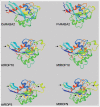Comparative phylogenetic and expression analysis of small GTPases families in legume and non-legume plants
- PMID: 29452030
- PMCID: PMC5846509
- DOI: 10.1080/15592324.2018.1432956
Comparative phylogenetic and expression analysis of small GTPases families in legume and non-legume plants
Abstract
Background: Small monomeric GTPases act as molecular switches in several processes that involve polar cell growth, participating mainly in vesicle trafficking and cytoskeleton rearrangements. This gene superfamily has largely expanded in plants through evolution as compared with other Kingdoms, leading to the suggestion that members of each subfamily might have acquired new functions associated to plant-specific processes. Legume plants engage in a nitrogen-fixing symbiotic interaction with rhizobia in a process that involves polar growth processes associated with the infection throughout the root hair. To get insight into the evolution of small GTPases associated with this process, we use a comparative genomic approach to establish differences in the Ras GTPase superfamily between legume and non-legume plants.
Results: Phylogenetic analyses did not show clear differences in the organization of the different subfamilies of small GTPases between plants that engage or not in nodule symbiosis. Protein alignments revealed a strong conservation at the sequence level of small GTPases previously linked to nodulation by functional genetics. Interestingly, one Rab and three Rop proteins showed conserved amino acid substitutions in legumes, but these changes do not alter the predicted conformational structure of these proteins. Although the steady-state levels of most small GTPases do not change in response to rhizobia, we identified a subset of Rab, Rop and Arf genes whose transcript levels are modulated during the symbiotic interaction, including their spatial distribution along the indeterminate nodule.
Conclusions: This study provides a comprehensive study of the small GTPase superfamily in several plant species. The genetic program associated to root nodule symbiosis includes small GTPases to fulfill specific functions during infection and formation of the symbiosomes. These GTPases seems to have been recruited from members that were already present in common ancestors with plants as distant as monocots since we failed to detect asymmetric evolution in any of the subfamily trees. Expression analyses identified a number of legume members that can have undergone neo- or sub-functionalization associated to the spatio-temporal transcriptional control during the onset of the symbiotic interaction.
Keywords: Arf; Rab; Rop; biological nitrogen fixation; comparative genomics; symbiosis.
Figures






Similar articles
-
Legume small GTPases and their role in the establishment of symbiotic associations with Rhizobium spp.Plant Signal Behav. 2009 Apr;4(4):257-60. doi: 10.4161/psb.4.4.7868. Plant Signal Behav. 2009. PMID: 19794839 Free PMC article. Review.
-
Comparative phylogenetic analysis of small GTP-binding genes of model legume plants and assessment of their roles in root nodules.J Exp Bot. 2008;59(14):3831-44. doi: 10.1093/jxb/ern223. Epub 2008 Oct 9. J Exp Bot. 2008. PMID: 18849296 Free PMC article.
-
Genome-Wide Identification of the CrRLK1L Subfamily and Comparative Analysis of Its Role in the Legume-Rhizobia Symbiosis.Genes (Basel). 2020 Jul 14;11(7):793. doi: 10.3390/genes11070793. Genes (Basel). 2020. PMID: 32674446 Free PMC article.
-
A small GTPase of the Rab family is required for root hair formation and preinfection stages of the common bean-Rhizobium symbiotic association.Plant Cell. 2009 Sep;21(9):2797-810. doi: 10.1105/tpc.108.063420. Epub 2009 Sep 11. Plant Cell. 2009. PMID: 19749154 Free PMC article.
-
Hormone modulation of legume-rhizobial symbiosis.J Integr Plant Biol. 2018 Aug;60(8):632-648. doi: 10.1111/jipb.12653. Epub 2018 Jun 5. J Integr Plant Biol. 2018. PMID: 29578639 Review.
Cited by
-
Transcriptome-wide identification and characterization of the Rab GTPase family in mango.Mol Biol Rep. 2020 Jun;47(6):4183-4197. doi: 10.1007/s11033-020-05519-y. Epub 2020 May 22. Mol Biol Rep. 2020. PMID: 32444976
-
Salt-induced expression of intracellular vesicle trafficking genes, CaRab-GTP, and their association with Na+ accumulation in leaves of chickpea (Cicer arietinum L.).BMC Plant Biol. 2020 Oct 14;20(Suppl 1):183. doi: 10.1186/s12870-020-02331-5. BMC Plant Biol. 2020. PMID: 33050887 Free PMC article.
-
Phylogenetic and Expression Studies of Small GTP-Binding Proteins in Solanum lycopersicum Super Strain B.Plants (Basel). 2022 Feb 26;11(5):641. doi: 10.3390/plants11050641. Plants (Basel). 2022. PMID: 35270112 Free PMC article.
-
Genetic Diversity, Nitrogen Fixation, and Water Use Efficiency in a Panel of Honduran Common Bean (Phaseolus vulgaris L.) Landraces and Modern Genotypes.Plants (Basel). 2020 Sep 19;9(9):1238. doi: 10.3390/plants9091238. Plants (Basel). 2020. PMID: 32961677 Free PMC article.
-
The Small GTPases in Fungal Signaling Conservation and Function.Cells. 2021 Apr 28;10(5):1039. doi: 10.3390/cells10051039. Cells. 2021. PMID: 33924947 Free PMC article. Review.
References
Publication types
MeSH terms
Substances
LinkOut - more resources
Full Text Sources
Other Literature Sources
